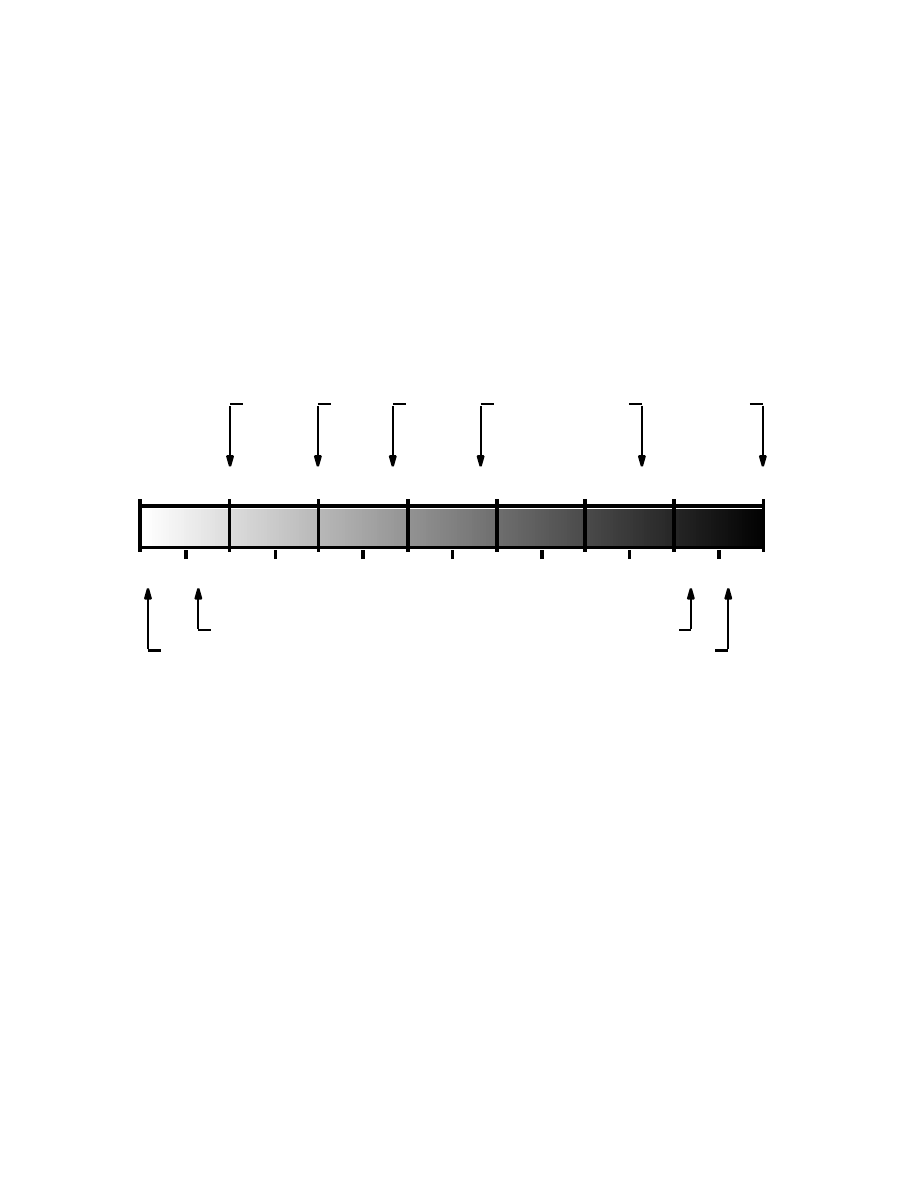ВУЗ: Казахская Национальная Академия Искусств им. Т. Жургенова
Категория: Учебное пособие
Дисциплина: Не указана
Добавлен: 03.02.2019
Просмотров: 12327
Скачиваний: 6

S
sound module: See tone module.
sound-on-sound: The same as overdubbing.
sound pressure level (SPL): The amplitude of an acoustic wave stated in dB that is propor-
tional to the logarithm of its acoustic intensity. A sound wave progressing through air causes
the instantaneous air pressure at any given point to vary above and below the barometric
pressure in accordance with the waveform of the sound. This variation in pressure is used as a
quantitative measure of the strength of the sound, and is called sound pressure. This is the
quantity which a pressure microphone measures, and if it is expressed on a dB scale and refer-
enced to a pressure of 20 µpascals, it is called the sound pressure level. The amplitude dy-
namic range of human hearing goes from 0dB, or 10
-16
watt/sq.cm., the upper threshold of
human hearing to 130dB or
10
-4
watt/sq.cm., the threshold of pain, a factor of 10
13
in range.
20
200
2,000
20,000
200,000
2,000,000
20,000,000
0
10
20
30
40
50
60
70
80
90
100
110
120
130
µPa
dB SPL
Quiet
Whisper
Home
Factory
Loud
Classical
Music
Loud
Rock
Music
Very Loud
Rock Music
Threshold of hearing
Sound studio background noise
Concorde
Threshold of pain
sound quality: The timbre of the sound, modified by the following parameters:
Sound Quality
Technical Term
Parameter
Overall Timbre
Harmonic Content
Oscillator Waveform
Brightness
Amplitude of HF Harmonics
Filter Rolloff
Tone Changes
Dynamic Filtering
VCF Envelope
Volume Changes
Dynamic Amplitude
VCA Envelope
Vibrato
Pitch Modulation
LFO to Pitch
Tremolo
Amplitude Modulation
LFO to VCA
Pitch
Frequency
Oscillator Tuning
Note Start Speed
Attack Time
VCA Envelope: Attack
Note Stop Speed
Release Time
VCA Envelope: Release
Percussiveness
Attack Treatments
VCA Envelope: Decay
sound reader: A magnetic playback head mounted either directly on a sync block, or on a free-
standing metal base with alignment rollers. Used by film editors to check synchronization of
all effects and music, they slowly hand-crank the workprint and various rolls of magnetic film
through a sync block on the editing bench. Signal from the sound reader is amplified by a
squawk box.

S
sound reinforcement: The general term for a sound system designed to amplify the voice
and/or music to improve its intelligibility to an audience. A sound reinforcement system al-
ways consists of at least one microphone and associated preamps, control console, amplifiers
and loudspeakers. Often abbreviated SR.
Sound Resource Format: A Macintosh file format, usually abbreviated SND, which tends to
be used for small, short sound effects, such as beeps and clicks. They were originally used for
system sounds. AIFF and QuickTime formats are more commonly used to record narration or
music, especially on larger files.
sound stage: A theatrical stage for filming that is specially treated for the simultaneous re-
cording of dialogue and/or music. A sound stage must have a low NC curve and a low rever-
beration time, and the cameras and other equipment used must be specially designed for quiet
operation. This is not the same as a re-recording stage.
sound stripe: A narrow strip of magnetic material applied to one edge of motion picture film
for recording of the film soundtrack, in the manner of a tape recorder. 70mm release prints of
motion pictures exclusively use magnetic soundtracks, as do some 35mm prints. Compare
with SVA. See stripe.
sound synthesis: The process of electronically creating a sound with an oscillator. Types of
sound synthesis include additive synthesis, subtractive synthesis, sample (playback) synthesis, FM
synthesis, and physical modeling synthesis, VPM.
sound system equalization: The equalization of a sound reinforcement system, either to in-
crease its amount of gain before feedback, or to make its overall frequency response more linear.
soundtrack: See film soundtrack.
source track: Audio input into the mixdown process. (1) Generically refers to the music con-
tained in a film, although it literally means the entire audio portion of a film, video or televi-
sion production, including effects and dialog. (2) Also refers to the physical space on film that
contains the audio information.
SOX: Start Of eXclusive. A MIDI message used to indicate the start of a System-Exclusive
message.
spaced microphone recording: Stereo recording techniques including Decca trees, binaural, bin-
aural synthesis, spaced pair, etc. which produce a large difference signal between the left and
right channels. Spaced pairs should be placed directly in front of the sound source with a
spacing of between one-half and one-third the width of the actual sound stage. Contrast with
coincident pair.

S
spaced pair: A stereo microphone technique where two or more microphones are pointed di-
rectly at the source, separated by two feet or more, according to the width of the sound stage.
Depending on the mic-to-source distance, this method can provide an extremely wide (occa-
sionally exaggerated) stereo perspective. (It is possible to move one mic forward a bit to
equalize balance without sacrificing phase or stereo image.) While spaced mics produce the
widest stereo image, they can suffer poor mono compatibility. The use of more than two micro-
phones is called a spaced array. Spaced microphone techniques can use either omnidirectional
microphones or directional microphones. See coincident pair, near-coincident pair, spaced micro-
phone recording, Faulkner array.
spacer: Plastic tape in different colors used to separate sections of film or magnetic tape, used
for the purposes of identification or protection. See also leader.
S/PDIF: Sony/Philips Digital Interface Format. A consumer standard, similar to the profes-
sional AES/EBU standard, for encoding digital audio. Given the international standard num-
ber IEC-958, S/PDIF was originally designed to be the standard for transmitting audio data
between CD players and DAT players, at a time when DAT was thought to be the next con-
sumer audio recording medium. The data transmission is the same as AES/EBU: four times
the sample rate. S/PDIF uses either standard unbalanced coaxial cable and phono jacks, or fibre
optic cable and a connector called a Toslink, usually at -10dB. Note that the coax is not an RCA
audio cable, but a video-grade cable: the impedance on this cable is 75
Ω
, and that S/PDIF car-
ries the SCMS copy code. S/PDIF is a self-clocking scheme. The EIAJ has adopted S/PDIF as
CP-340 Type II.
speaker simulator: The sound produced by guitar and, to a lesser extent, bass amplifiers is
dramatically affected by the actual loudspeaker cabinet through which the amplifier is played.
This is due to the speaker itself which does not reproduce high-end frequencies well. A
speaker simulator emulates the frequency response of a conventional loudspeaker cabinet and
is typically built in as a part of a DI box, combining the elements of the DI with the simulator.
Speakon: See Neutrik.
spectral gain intermodulation: The misuse of a (manual) compressor, set to high ratios and fast
attack and release constants, producing loss of transients, loss of high-end, and other undesir-
able effects such as a kick drum ducking the vocals. The remedy for spectral gain intermodula-
tion is to set a low threshold to bring low signals up, but also to be less extreme in the ratio,
attack, and release settings. See also breathing.
spectral recording (SR): See Dolby SR™.
spectrum: The range of frequencies present in a waveform, such as an audio signal. When a
time-varying signal is subjected to frequency analysis, it is transformed from the time domain
to the frequency domain. The frequency-domain representation of the signal is called the spec-
trum, and the time domain representation is called the waveform. The two quantities contain
the same information, and one can be converted into the other by a mathematical operation of
the Fourier transform. Spectrum analysis, frequency analysis, and Fourier analysis are synony-
mous.
spectrum shifter: See frequency shifter.

S
speed: Called out by the production sound mixer on-location, indicating to the camera crew
and others that the audio recording chain is now recording.
spill: See leakage.
spiral: The widely separated grooves that follow the last selection on a record, leading the
stylus quickly toward the center groove. Also called the tail-out on mastering lathe controls.
The less-widely separated grooves preceding the first selection on a record are called the lead-
in.
splice: The joint made between two pieces of magnetic tape or motion picture film in the
process of editing. Or, the point in audio or screen time at which this joint occurs.
split-band: The analysis or processing of a signal by separating its frequency spectrum into
discrete regions, or bands. See split-band coding, split-band compression.
split-band coding: A transform encoding/decoding technique where the signal is split into a
number of independent bands, used to take advantage of the spectral redundancies within the
audio spectrum. A type of split-band encoding is sub-band coding.
spilt-band compression: Compression where different sections of the audio spectrum are
compressed separately. With a wideband compressor, if there is a dominant portion of the
spectrum, no matter how small, it affects the whole waveform. With split-band devices, the
greatest effect is with high ratios, where the effect is more like localized limiting. Split-band
compressors are similar to multiband audio processors in the first stage of audio processing.
split console: A mixer where the monitor section is actually another complete mixer; the re-
cording input and monitoring functions are entirely separate. The structure of a split console
is: input channels, groups, tape monitor channels, and stereo output. This type of design
quickly becomes unwieldy as the number of tracks increases, and performing simple functions
such as bounce-downs often requires external signal patching to re-route monitor returns
through input channels and on to the group sends. The opposite of an in-line mixer.
split feed: (1) The process of routing the same signal to two or more separate outputs, mod-
ules, or devices. (2) The actual device that allows the signal to be routed to more than one
destination. Also called a Y-connector.
split keyboard: A single keyboard is divided electronically to act as if it were two or more
separate ones, separated into zones at a split point or points. The output of each note range is
routed into a separate signal path in the keyboard’s internal sound producing circuitry or
transmitted over one or more separate MIDI channels. Applications include playing a bass
sound with the left hand while playing a piano sound with the right.
split point: Where two keyboard zones adjoin, but do not overlap, on a split keyboard, the divi-
sion between them is called the split point. Where the zones overlap, they are called layers.
split reel: A film reel that can be separated into two separate flanges, so that the film itself,
wound on a plastic core, can be stored without reels. Used constantly in editing pictures and
magnetic film.

S
split surrounds: Also known as stereo surrounds. A term used to refer to the Dolby 70mm
sound format that gives two surround channels (LR, RR) on a mono-surround-compatible
print. Also indicates the use of separate surround speakers in any sound format which have
two (or more) discrete surround tracks.
SPP: See Song Position Pointer.
spot-erase: To erase a very small segment of recorded tape, on one track or all. Most accu-
rately done by slowing down the tape by varispeed, enabling the engineer to punch-in and -out
at exact points marked on the tape itself.
spotting: Used in film scoring, the process of identifying the specific scenes on film where
music cues will take place, including information on length and style. Also, the act of review-
ing the film with the director to determine work that will be needed on the soundtrack.
spring reverb: An electromechanical effects device that uses springs to simulate natural room
or hall reverberation. Spring reverbs work basically like plate reverb systems, but are much
smaller and produce an inferior effect. A transducer sets up vibrations in the spring which rat-
tles back and forth, extracted by a pick-up at the other end. The character of a particular
spring reverb unit is fixed (other than wet/dry balance), but can be optimized for the sound
source at the design stage by careful choice of the number, length, diameter, and compliance of
the spring(s). Also called a spring-line reverb.
square wave: A square wave is a periodic waveform which consists of a fundamental and all
odd-numbered harmonics. The harmonics gradually decrease in amplitude as frequency rises,
and they are in phase with the fundamental. The square wave is a good test signal because it
exercises the device at many frequencies at the same time, as does music. Also called a pulse
wave. See duty cycle, Appendix C.
squawk box: A small table-top amplifier and speaker used for playback of magnetic film
passing through a sound reader. The poor sound quality is reflected in the name of the device.
See bench.
SR: Used as an abbreviation for (1) sound reinforcement or (2) spectral recording. See Dolby-SR,
Dolby SR.D.
S.R.: Senza Repeats, as in “play from the sign without repeats,” written D.S. (S.R.).
SR noise: See biased noise.
SR.D: See Dolby SR.D™.
SSL: (1) Solid-State Logic, circuitry composed of only solid-state components, as opposed to
vacuum-tube devices. (2) A company which makes large, expensive mixers.
staccato: Italian for “short.” Used to indicate that notes should have a short duration and be
detached as widely as possible from one another. The opposite of legato.
staff: See stave.